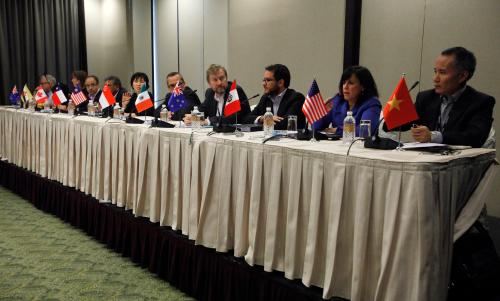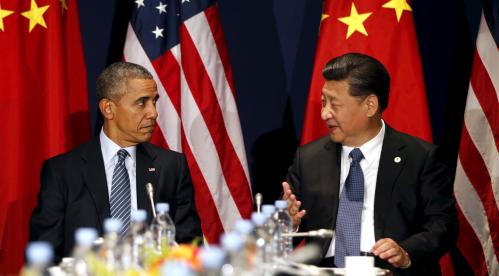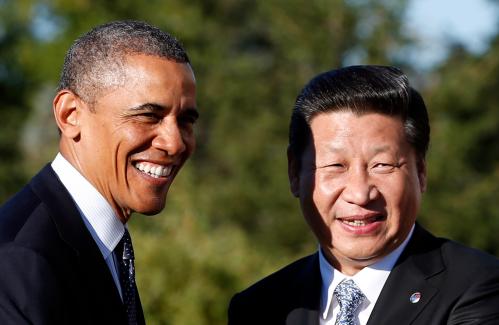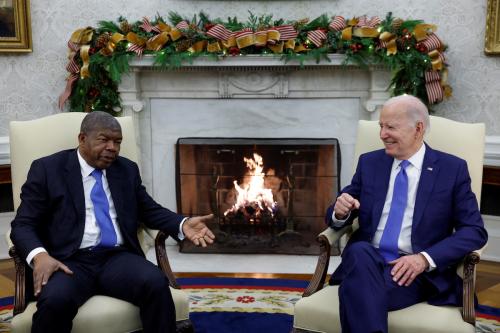Content from the Brookings-Tsinghua Public Policy Center is now archived. Since October 1, 2020, Brookings has maintained a limited partnership with Tsinghua University School of Public Policy and Management that is intended to facilitate jointly organized dialogues, meetings, and/or events.
President Obama is travelling to the Chinese city of Hangzhou for the Group of 20 meeting later this week, where he’ll meet with the president of China for the 17th time since taking office. This is an appropriate time to reflect on U.S. relations with China, American interests in Asia, and Obama’s accomplishments in the region.
On rare occasions, international issues are resolved by a dramatic, decisive development—the collapse of the Soviet Union and the reunification of Germany come to mind. Much more often, progress is incremental. Or as President Obama has said, an administration hits more singles and doubles than home runs. Under Obama, that has been the nature of the American achievement in Asia.
Asia’s success stories
Unlike the Middle East, which is in seemingly permanent turmoil and crisis, or Europe, whose unity and institutions are threatened, Asia is economically dynamic and generally stable and peaceful. It is the fastest growing region in the world, the home of many of the companies and much of the technology driving the global economy, and the source of hundreds of billions of dollars in trade and investment, as well as accompanying jobs in the United States.
This positive state of affairs is the product of bipartisan policies under both Democratic and Republican administrations that built strong alliances, a high level of economic interaction with Asian partners, constructive relations with a rising China, and a robust military presence in the region.
Obama believed U.S. interests lay in deeper engagement in a part of the world marked by success stories rather than failed states, much as throughout our history our deepest overseas ties have been with a prosperous and dynamic Europe. That has meant neither lazy affirmation of the region’s status quo nor efforts at destabilizing transformation. It has required the right balance in dealing with a China whose growing economic, military, and political strength is viewed with anxiety by many of the region’s peoples and as a potential strategic rival by Americans.
Obama’s policy toward China has built on the efforts of every presidential administration since Richard Nixon. It has been grounded in several principles: accepting increased influence for a China that rises peacefully and plays by international rules; building an extensive network of interconnections and ties with Chinese elites and ordinary people; providing assurance to allies and partners in the region of enduring U.S. security commitments and presence that will meet any foreseeable challenge; and creating a formal framework of multilateral cooperation encompassing the United States, China, and various regional states.
Major achievements have included the establishment of democracy in Myanmar (Burma); the American decision to join the East Asia Summit and begin efforts to turn it into a significant regional security forum; the measurable strengthening of security relationships with Japan, South Korea, and other allies; and deepened relations with the 10 countries of the Association of Southeast Asian Nations (ASEAN).
With China, Obama has taken steps to improve cooperation and transparency, along with measures to strengthen the security of the United States and its regional allies. The United States and China have concluded military-to-military agreements designed to avoid incidents on the high seas and in international air space. The Obama administration has worked with China to successfully freeze Iran’s nuclear weapons program; place caps on growth of greenhouse gases that cause climate change; and halt cybertheft of the intellectual property of U.S. companies. But the United States also has also ramped up its naval presence in the South China Sea and laid out comprehensively for the first time our principles there, largely validated by the 2016 Permanent Court of Arbitration ruling on the China-Philippines dispute. It has overseen a transfer of some of the United States’ most advanced naval and air force systems to the Pacific theater, and it has reaffirmed U.S. defense assurances to Japan covering Japanese-administered islands in the East China Sea challenged by China.
Unfinished tasks
With President Obama soon to hold his last meetings with Chinese President Xi Jinping and other Asian leaders, there are two principal challenges to the generally positive trajectory of U.S. policy toward Asia.
The first is the continuing difficulties in managing and reacting to China’s rise. Will China address territorial conflicts peacefully in the South China Sea; cooperate in rolling back North Korea’s nuclear weapons program; build a positive, normal relationship with Japan; and manage its differences with Taiwan without military conflict? Will China work toward a politically more sustainable trade and investment regime and dismantle nationalist and mercantilist policies that encourage other countries to erect retaliatory barriers and decrease global prosperity? China, not the United States, will answer these questions, but the kind of relationship the United States has with China will help shape the answers. Neither an American policy of containment nor one of isolationism will produce the desired outcomes to these challenges. None have been resolved during Obama’s time, but he has made ample progress and laid out a realistic and balanced framework that the next president would do well to heed.
The second is the domestic mood in the United States. Casual proposals by Donald Trump to allow Japan and South Korea to acquire nuclear weapons, to abandon our alliances if our partners don’t pay their “fair share,” to impose 45 percent tariffs on China, and to turn away from promotion of free trade would individually and collectively undo the achievements of President Obama and his predecessors in helping to build a prosperous, peaceful Asia that well serves American interests. The Trans-Pacific Partnership trade agreement (TPP), negotiation of which was one of the signature achievements of President Obama’s Asia policy, may be a casualty of American domestic politics. If TPP cannot be approved by Congress this year, it is essential that it, or a satisfactory modified agreement, be approved quickly under the next administration. Otherwise, people in Asia who have long looked to the United States as an essential partner may conclude that our interests do not include them.







Commentary
Obama’s China and Asia policy: A solid double
August 29, 2016